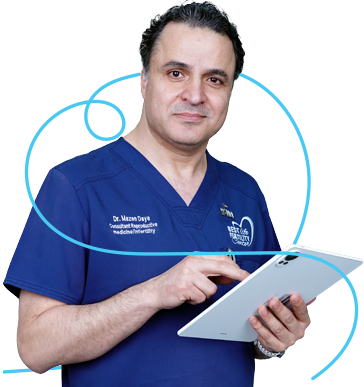Obstructive azoospermia is a common yet treatable cause of male infertility. This guide breaks down the condition, its causes, diagnostic tools, and treatment options to help you make informed decisions before seeking care.
Male fertility issues account for approximately 40–50% of all infertility cases in couples trying to conceive. One of the most common male-related causes is azoospermia, a condition where there is no measurable sperm in the ejaculate. Of the two types—obstructive and non-obstructive—obstructive azoospermia tends to be more manageable, thanks to advanced diagnostic tools and targeted male infertility treatment options.
If you’re dealing with a low or no sperm count, and suspect or have been diagnosed with obstructive azoospermia, this comprehensive guide will help you understand what steps to take next, what to expect from the diagnostic process, and how modern medicine can help you on your journey to parenthood.
What Is Obstructive Azoospermia?
Obstructive azoospermia occurs when sperm production in the testes is normal, but a physical blockage in the male reproductive tract prevents sperm from entering the ejaculate. This differs from non-obstructive azoospermia, which results from impaired sperm production itself.
The blockage can occur at various points in the reproductive tract, including:
- Epididymis (called epididymal obstruction)
- Vas deferens (e.g., due to congenital absence or surgical blockage)
- Ejaculatory ducts
In obstructive cases, sperm is often present in the testes or nearby structures, which makes sperm retrieval techniques a viable option for conception through assisted reproductive techniques like IVF with ICSI (Intracytoplasmic Sperm Injection).
Causes of Obstructive Azoospermia
Understanding the causes of azoospermia is critical to developing the right treatment plan. The most common reasons for obstruction include:
1. Congenital Absence of Vas Deferens
Some men are born without a vas deferens—a condition often linked to mutations in the CFTR gene (commonly associated with cystic fibrosis).
2. Infections
Past infections such as epididymitis or sexually transmitted infections (STIs) can cause scarring and obstruction in the reproductive tract.
3. Surgical Interventions
Procedures like vasectomy are deliberate causes of vas deferens blockage. While reversible in some cases, they may lead to longer-term obstructions.
4. Trauma or Injury
Pelvic or testicular trauma can lead to structural damage or scarring in the reproductive tract.
5. Cysts or Ejaculatory Duct Blockage
Blockages at the level of the ejaculatory duct, often due to Müllerian duct cysts, can prevent sperm from mixing with seminal fluid.
Symptoms and When to Seek Evaluation
Obstructive azoospermia usually has no outward symptoms, which is why it often goes unnoticed until a fertility evaluation is conducted. Signs that may prompt further investigation include:
- Inability to conceive after 6–12 months of trying
- Normal sexual function but no sperm in semen
- History of infections, surgeries, or trauma to the groin area
If you and your partner are facing difficulties conceiving, a reproductive urologist or fertility specialist can initiate appropriate diagnostic tests.
Diagnosis of Obstructive Azoospermia
Diagnosing obstructive azoospermia involves a comprehensive approach to evaluating male reproductive health. The diagnostic process typically includes:
1. Semen Analysis
This test is performed to assess sperm count, motility, and morphology. A result showing zero sperm in two separate samples taken at least a few weeks apart raises a red flag.
2. Hormonal Evaluation
Blood tests help differentiate obstructive from non-obstructive causes by assessing levels of FSH (Follicle Stimulating Hormone), LH, and testosterone. Men with obstructive azoospermia typically have normal hormone levels.
3. Scrotal Ultrasound
Used to evaluate testicular size and detect structural abnormalities such as dilated epididymis.
4. Transrectal Ultrasound (TRUS)
TRUS is particularly useful for visualizing blockages in the ejaculatory ducts or seminal vesicles.
5. Genetic Testing
Especially in cases where congenital absence of the vas deferens is suspected. This test may identify CFTR gene mutations.
6. Testicular Biopsy
A small tissue sample is collected to assess sperm production directly. If sperm are found in the testis but not in the ejaculate, the obstruction is confirmed.
Treatment for Obstructive Azoospermia
Once diagnosed, treatment depends on the underlying cause and the couple’s reproductive goals. Options may include surgical correction, sperm retrieval, or assisted reproduction.
1. Surgical Repair of the Blockage
In cases where a correctable blockage is identified (such as vasectomy reversal or ejaculatory duct obstruction), microsurgical procedures may restore natural fertility.
- Vasovasostomy: Reconnecting severed vas deferens.
- Vasoepididymostomy: Creating a bypass between vas deferens and epididymis when the obstruction is in the epididymis.
- Transurethral Resection of Ejaculatory Ducts (TURED): Removes blockage at the ejaculatory duct level.
These procedures require expertise and are usually performed by a reproductive urologist.
2. Sperm Retrieval Techniques
When surgical repair isn’t viable or preferred, sperm can be retrieved directly from the testes or epididymis and used in IVF treatments:
- PESA (Percutaneous Epididymal Sperm Aspiration)
- TESA (Testicular Sperm Aspiration)
- TESE (Testicular Sperm Extraction)
- Micro-TESE: A more precise technique guided by microscopy.
These methods are often combined with IVF with ICSI, where a single sperm is injected directly into an egg.
3. Assisted Reproductive Techniques
For many couples, assisted reproductive options are the fastest and most effective route to pregnancy.
- IVF with ICSI is the most common and successful approach.
- In some cases, multiple sperm retrieval attempts may be needed.
Sperm retrieved can also be cryopreserved for future IVF cycles.
Emotional and Psychological Support
Facing a diagnosis of obstructive azoospermia can be emotionally challenging. It’s crucial to recognize that male infertility does not reflect masculinity or self-worth. Professional counseling, support groups, and open communication with your partner are essential components of the fertility journey.
What to Expect Before Treatment Begins
Before embarking on treatment, here are some important steps to take:
- Comprehensive Evaluation
Ensure you complete a full diagnostic workup. This prevents unnecessary treatments and helps target the root cause. - Understand All Your Options
Discuss both surgical and non-surgical options with your doctor. Each has its pros and cons depending on the case. - Fertility Preservation
If undergoing surgical procedures or sperm retrieval, consider sperm freezing to avoid repeated procedures. - Partner Evaluation
Your partner should also undergo a fertility assessment to rule out any concurrent issues. - Choosing the Right Clinic
Look for a facility that offers integrated urology and fertility services with access to experienced specialists and advanced technologies.
Conclusion
Obstructive azoospermia is a treatable form of male infertility, and with today’s advances in diagnostics and treatment, many men successfully become biological fathers through surgery, sperm retrieval techniques, or IVF with ICSI.
If you’re navigating this journey and seeking clarity, working with experienced specialists is key. For those in the UAE, Best Life Fertility Center offers access to comprehensive fertility care under the expertise of Dr. Mazen Al-Dayeh, a respected leader in male reproductive health.
Ready to Take the Next Step in Your Fertility Journey?
If you suspect obstructive azoospermia or have been diagnosed with a form of male infertility, timely evaluation and treatment can make a significant difference. Consulting a reproductive urologist can help you understand your options—from accurate diagnosis to effective sperm retrieval and assisted reproductive techniques like IVF with ICSI. For expert guidance, Dr. Mazen Al-Dayeh and the team at Best Life Fertility Center in Dubai are trusted names in male reproductive health and advanced fertility care. Schedule a consultation today to explore the most suitable path forward.




















